The unmanned railway vehicle washing systems industry stands at the threshold of a decade-long expansion trajectory that promises to reshape rail maintenance and automated cleaning technology. The market's journey from USD 997.9 million in 2025 to USD 1,890.9 million by 2035 represents substantial growth, demonstrating the accelerating adoption of advanced automated washing systems and maintenance technologies across rail operators, transportation authorities, and railway maintenance facilities worldwide.
The first half of the decade (2025-2030) will witness the market climbing from USD 997.9 million to approximately USD 1,288.6 million, adding USD 290.7 million in value, which constitutes 32.5% of the total forecast growth period. This phase will be characterized by the rapid adoption of automated washing systems, driven by increasing rail network modernization and maintenance automation programs worldwide. Advanced cleaning capabilities and integrated monitoring features will become standard expectations rather than premium options.
The latter half (2030-2035) will witness growth from USD 1,288.6 million to USD 1,890.9 million, representing an addition of USD 602.3 million or 67.5% of the decade's expansion. This period will be defined by mass market penetration of comprehensive automated cleaning platforms, integration with rail management systems, and seamless compatibility with existing railway infrastructure. The market trajectory signals fundamental shifts in how rail operators approach vehicle maintenance and cleaning, with participants positioned to benefit from demand across multiple application segments.
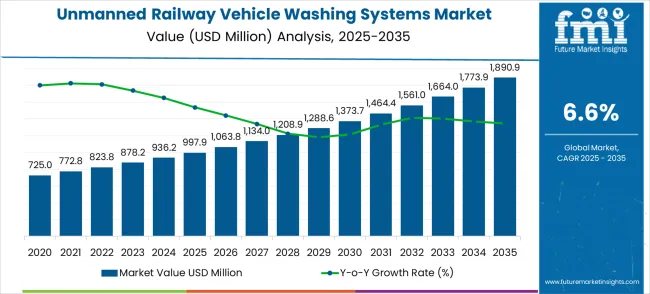
The Unmanned Railway Vehicle Washing Systems market demonstrates distinct growth phases with varying market characteristics and competitive dynamics. Between 2025 and 2030, the market progresses through its automation adoption phase, expanding from USD 997.9 million to USD 1,288.6 million with steady annual increments averaging 5.2% growth. This period showcases the transition from basic washing systems to advanced automated platforms with enhanced cleaning capabilities and integrated maintenance workflow systems becoming mainstream features.
The 2025-2030 phase adds USD 290.7 million to market value, representing 32.5% of total decade expansion. Market maturation factors include standardization of automated cleaning protocols, declining manufacturing costs for washing systems, and increasing rail operator awareness of unmanned washing benefits, reaching 88-92% efficiency in cleaning applications. Competitive landscape evolution during this period features established cleaning equipment companies like Kärcher and Westmatic expanding their railway automation portfolios while new entrants focus on specialized cleaning algorithms and enhanced integration capabilities.
From 2030 to 2035, market dynamics shift toward advanced integration and multi-platform deployment, with growth accelerating from USD 1,288.6 million to USD 1,890.9 million, adding USD 602.3 million or 67.5% of total expansion. This phase transition logic centers on comprehensive cleaning platforms, integration with railway management systems, and deployment across diverse transportation specialties, becoming standard rather than specialized applications. The competitive environment matures with focus shifting from basic cleaning capability to comprehensive railway maintenance ecosystems and integration with automated monitoring and fleet management platforms.
At-a-Glance Metrics
| Metric | Value |
|---|---|
| $ Market Value (2025) → | USD 997.9 million |
| $ Market Forecast (2035) ↑ | USD 1,890.9 million |
| # Growth Rate ★ | 6.6% CAGR |
| Leading System Type → | Stationary Washing Systems |
| Primary Application → | Subway Vehicle Cleaning |
The market demonstrates strong fundamentals with Stationary Washing Systems capturing a dominant share through advanced cleaning features and cost-effective implementation capabilities. Subway Vehicle Cleaning applications drive primary demand, supported by increasing rail operator spending on maintenance automation tools and cleaning enhancement systems. Geographic expansion remains concentrated in developed markets with established railway infrastructure, while emerging economies show accelerating adoption rates driven by rail modernization and rising maintenance automation budgets.
Market expansion rests on three fundamental shifts driving adoption across the railway and transportation sectors. 1. Operational efficiency demand creates compelling operational advantages through automated washing systems that provide consistent cleaning without labor dependency risks, enabling rail operators to maintain vehicle cleanliness while achieving operational superiority and reducing maintenance costs. 2. Railway modernization programs accelerate as transportation authorities worldwide seek advanced automated systems that complement traditional maintenance methods, enabling precise vehicle cleaning and monitoring applications that align with operational standards and efficiency requirements. 3. Railway infrastructure enhancement drives adoption from metro operators and rail companies requiring effective cleaning tools that minimize maintenance errors while maintaining fleet appearance quality during complex operational procedures and service planning.
The growth faces headwinds from capital investment challenges that vary across operators regarding the deployment of automated washing systems and maintenance budget protocols, which may limit operational flexibility in certain railway environments. Technical limitations also persist regarding system adaptability and integration complexity that may reduce system performance with legacy rail equipment or non-standardized vehicle formats that limit cleaning capabilities.
The unmanned railway vehicle washing systems market represents a transformative growth opportunity, expanding from USD 997.9 million in 2025 to USD 1.89 billion by 2035 at a 6.6% CAGR. As railway systems worldwide prioritize operational efficiency, maintenance automation, and fleet management, automated washing systems have evolved from optional equipment to mission-critical infrastructure, enabling consistent cleaning, reducing labor costs, and supporting operational excellence across subway, high-speed rail, and urban transit applications.
The convergence of railway automation mandates, increasing passenger service quality requirements, maintenance technology maturation, and regulatory acceptance of automated systems creates unprecedented adoption momentum. Advanced cleaning algorithms offering superior efficiency, seamless railway integration, and operational compliance will capture premium market positioning, while geographic expansion into emerging railway markets and scalable system deployment will drive volume leadership. Government transportation modernization programs and railway automation standardization provide structural support.
Primary Classification: The market segments by system type into Stationary Washing Systems and Mobile Washing Systems categories, representing the evolution from fixed installation solutions to flexible automated systems for comprehensive railway cleaning coverage.
Secondary Breakdown: Application segmentation divides the market into Subway Vehicle Cleaning, High-Speed Train Cleaning, Urban Tram Cleaning, Freight Train Cleaning, and Other sectors, reflecting distinct requirements for urban transit, intercity rail, freight operations, and specialized cleaning applications.
Regional Classification: Geographic distribution covers Asia Pacific, North America, Europe, Latin America, and the Middle East & Africa, with developed markets leading adoption while emerging economies show accelerating growth patterns driven by railway modernization programs.
The segmentation structure reveals technology progression from traditional fixed washing systems toward integrated automated platforms with enhanced flexibility and monitoring capabilities, while application diversity spans from subway cleaning to comprehensive rail maintenance solutions requiring precise automated assistance.
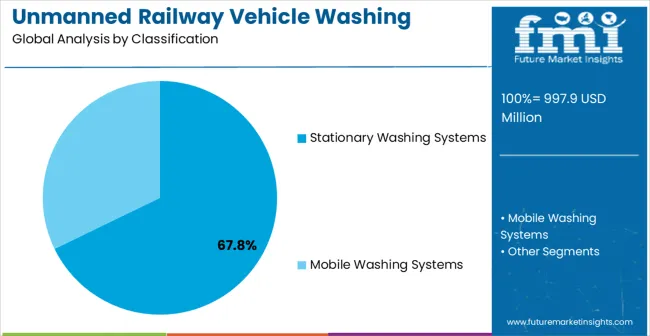
Market Position: Stationary Washing Systems command the leading position in the Unmanned Railway Vehicle Washing Systems market with approximately 67.8% market share through advanced cleaning features, including high throughput capacity, consistent performance, and comprehensive cleaning capabilities that enable rail operators to deploy automated washing across diverse depot environments without significant operational modifications.
Value Drivers: The segment benefits from rail operator preference for high-capacity washing systems that provide reliable cleaning results without requiring extensive mobility infrastructure or specialized maintenance protocols. Stationary system design features enable deployment in major rail depots, maintenance facilities, and high-volume operations where cleaning consistency and throughput represent critical operational requirements.
Competitive Advantages: Stationary systems differentiate through established cleaning efficiency, proven throughput capabilities, and integration with existing depot workflows that enhance maintenance effectiveness while maintaining cost-effective operational profiles suitable for rail operators of all sizes.
Key market characteristics:
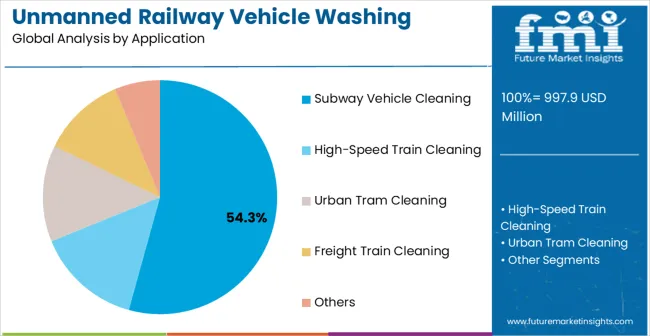
Market Context: Subway Vehicle Cleaning applications dominate the Unmanned Railway Vehicle Washing Systems market with approximately 54.3% market share due to widespread adoption of automated cleaning systems and increasing focus on urban transit maintenance, passenger service quality, and operational efficiency applications that optimize fleet appearance while maintaining cleaning effectiveness.
Appeal Factors: Subway customers prioritize system reliability, cleaning quality, and integration with existing transit infrastructure that enables coordinated maintenance across multiple vehicle types and service lines. The segment benefits from substantial urban transportation budgets and modernization programs that emphasize automated maintenance tool acquisition for improved service quality and operational efficiency.
Growth Drivers: Urban transit modernization programs incorporate automated washing systems as standard equipment for subway maintenance and fleet management applications. At the same time, increasing passenger service standards are driving demand for cleaning capabilities that maintain vehicle appearance requirements and minimize maintenance disruptions.
Market Challenges: Budget constraints and infrastructure limitations may limit system deployment in certain transit environments or operational scenarios.
Application dynamics include:
Growth Accelerators: Railway automation drives primary adoption as washing systems provide cleaning assistance capabilities that enable consistent vehicle maintenance without labor dependency risks, supporting operational decision-making and efficiency missions that require precise cleaning management. The demand for maintenance modernization accelerates market expansion as rail operators seek effective cleaning enhancement tools that minimize maintenance errors while maintaining operational effectiveness during complex service procedures and fleet management scenarios. Transportation spending increases worldwide, creating demand for automated cleaning systems that complement traditional maintenance equipment and provide operational flexibility in complex railway environments.
Growth Inhibitors: Capital investment challenges vary across operators regarding the deployment of automated washing systems and budget allocation protocols, which may limit operational flexibility and market penetration in regions with constrained railway budgets. Technical performance limitations persist regarding system adaptability and integration complexity that may reduce effectiveness with legacy rail equipment, non-standardized vehicle formats, or complex depot workflows that limit cleaning capabilities. Market fragmentation across multiple railway standards and operational requirements creates compatibility concerns between different washing system providers and existing maintenance infrastructure.
Market Evolution Patterns: Adoption accelerates in urban transit and railway sectors where operational efficiency justifies system costs, with geographic concentration in developed markets transitioning toward mainstream adoption in emerging economies driven by railway modernization and maintenance infrastructure development. Technology development focuses on enhanced cleaning efficiency, improved automation capabilities, and compatibility with diverse railway systems that optimize maintenance workflow and operational effectiveness. The market could face disruption if alternative cleaning technologies or budget restrictions significantly limit automated washing deployment in railway or transit applications.
The Unmanned Railway Vehicle Washing Systems market demonstrates varied regional dynamics with Growth Leaders including China (8.9% CAGR) and India (8.3% CAGR) driving expansion through railway modernization and transportation infrastructure development. Steady Performers encompass Germany (7.6% CAGR), Brazil (6.9% CAGR), and the USA(6.3% CAGR), benefiting from established railway industries and advanced maintenance automation adoption. Emerging Markets feature the UK (5.6% CAGR) and Japan (5.0% CAGR), where specialized railway applications and maintenance technology integration support consistent growth patterns.
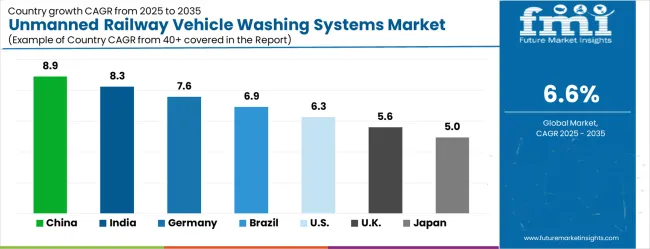
| Country | CAGR (2025-2035) |
|---|---|
| China | 8.9% |
| India | 8.3% |
| Germany | 7.6% |
| Brazil | 6.9% |
| USA | 6.3% |
| UK | 5.6% |
| Japan | 5.0% |
Regional synthesis reveals Asia-Pacific markets leading growth through railway modernization and transportation infrastructure development, while European countries maintain steady expansion supported by maintenance technology advancement and EU railway standardization requirements. North American markets show moderate growth driven by transit applications and railway technology integration trends.
China establishes market leadership through aggressive railway modernization programs and comprehensive transportation infrastructure development, integrating advanced unmanned washing systems as standard components in high-speed rail maintenance and urban transit operations. The country's 8.9% CAGR through 2035 reflects government initiatives promoting railway automation and domestic transportation capabilities that mandate advanced cleaning systems in rail depot installations. Growth concentrates in major transportation hubs, including Beijing, Shanghai, and Guangzhou, where railway technology development showcases integrated washing systems that appeal to domestic rail operators seeking advanced maintenance capabilities and operational enhancement applications.
Chinese manufacturers are developing cost-effective unmanned washing solutions that combine domestic production advantages with advanced features, including precision cleaning algorithms and comprehensive maintenance capabilities. Distribution channels through government transportation procurement and railway equipment suppliers expand market access, while government funding for railway technology development supports adoption across diverse transportation and maintenance segments.
Strategic Market Indicators:
In New Delhi, Mumbai, and Bangalore, railway authorities and metro operators are implementing advanced unmanned washing systems as standard equipment for train maintenance and fleet management applications, driven by increasing transportation spending and modernization programs that emphasize the use of automated cleaning capabilities. The market is projected to demonstrate an 8.3% CAGR through 2035, supported by government railway initiatives and transportation infrastructure development programs that promote the use of advanced maintenance tools for rail operators and metro authorities. Indian railway operators are adopting unmanned washing systems that provide superior cleaning capabilities and maintenance enhancement features, particularly appealing in urban regions where service quality represents critical operational requirements.
Market expansion benefits from growing railway technology capabilities and international technology transfer agreements that enable domestic development of advanced cleaning systems for transportation and maintenance applications. Technology adoption follows patterns established in transportation infrastructure, where operational efficiency and service quality drive procurement decisions and system deployment.
Market Intelligence Brief:
Germany's advanced railway technology market demonstrates sophisticated unmanned washing deployment with documented cleaning effectiveness in rail maintenance departments and transportation centers through integration with existing railway systems and maintenance infrastructure. The country leverages engineering expertise in railway technology and transportation systems integration to maintain a 7.6% CAGR through 2035. Transportation centers, including Munich, Berlin, and Hamburg, showcase premium installations where unmanned washing integrates with comprehensive railway information systems and maintenance platforms to optimize cleaning accuracy and operational workflow effectiveness.
German railway technology providers prioritize system reliability and EU regulatory compliance in unmanned washing development, creating demand for premium systems with advanced features, including maintenance validation and integration with European railway standards. The market benefits from established railway industry infrastructure and a willingness to invest in advanced cleaning technologies that provide long-term operational benefits and compliance with transportation regulations.
Market Intelligence Brief:
The market expansion in Brazil benefits from diverse transportation demand, including railway modernization in São Paulo and Rio de Janeiro, metro system upgrades, and government transportation programs that increasingly incorporate automated cleaning solutions for rail maintenance applications. The country maintains a 6.9% CAGR through 2035, driven by rising transportation awareness and increasing adoption of unmanned washing benefits, including superior cleaning capabilities and reduced operational costs.
Market dynamics focus on cost-effective unmanned washing solutions that balance advanced cleaning features with affordability considerations important to Brazilian rail operators. Growing transportation infrastructure creates demand for modern cleaning systems in new railway facilities and maintenance equipment modernization projects.
Strategic Market Considerations:
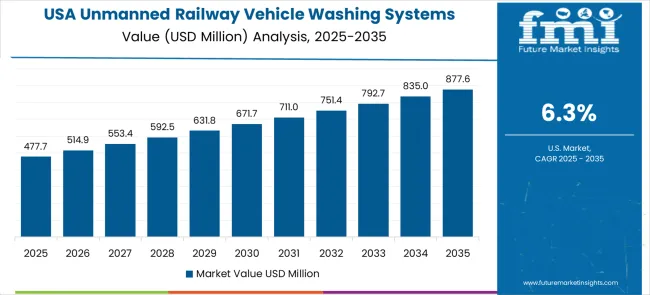
The USA market emphasizes advanced unmanned washing features, including precision cleaning algorithms and integration with comprehensive railway information systems that manage maintenance scheduling, fleet monitoring, and operational support applications through unified transportation platforms. The country is projected to show a 6.3% CAGR through 2035, driven by transportation modernization under railway equipment upgrades and federal transportation agency support for automated maintenance systems. American rail operators prioritize operational effectiveness with unmanned washing, delivering consistent cleaning assistance through advanced maintenance algorithms and operational compliance capabilities.
Technology deployment channels include major transportation technology contractors, specialized railway equipment suppliers, and transit authority programs that support professional installation for complex railway applications. Transportation platform integration capabilities with established maintenance systems expand market appeal across diverse cleaning requirements seeking operational efficiency and maintenance compliance benefits.
Performance Metrics:
Japan demonstrates steady market development with a 5.0% CAGR through 2035, distinguished by rail operators' preference for high-quality unmanned washing systems that integrate seamlessly with existing railway equipment and provide reliable long-term operation in specialized maintenance applications. The market prioritizes advanced features, including precision cleaning algorithms, maintenance validation, and integration with comprehensive railway platforms that reflect Japanese transportation expectations for technological sophistication and operational excellence.
In London, Manchester, and other transportation centers, British rail operators and metro authorities are implementing advanced unmanned washing systems to enhance maintenance capabilities and support operational decision-making that aligns with UK railway standards and transportation regulations. The UK market is expected to demonstrate growth with a 5.6% CAGR through 2035, driven by transportation modernization programs and railway equipment upgrades that emphasize advanced maintenance tools for rail and metro applications. British transportation facilities are prioritizing unmanned washing systems that provide superior cleaning capabilities while maintaining compliance with railway regulations and minimizing operational risks, particularly important in urban transit and specialized railway applications.
Market expansion benefits from transportation procurement programs that support automated maintenance capabilities in railway equipment specifications, creating demand across the UK's transportation sectors where operational effectiveness and regulatory compliance represent critical requirements. The regulatory framework supports unmanned washing adoption through transportation device standards and railway technology requirements that promote advanced maintenance systems aligned with national transportation capabilities.
Strategic Market Indicators:
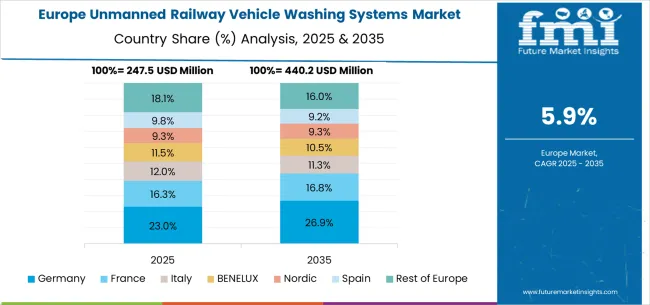
The Unmanned Railway Vehicle Washing Systems market in Europe is projected to grow from USD 217.4 million in 2025 to USD 412.3 million by 2035, registering a CAGR of 6.6% over the forecast period. Germany is expected to maintain its leadership position with a 33.8% market share in 2025, rising slightly to 34.2% by 2035, supported by its advanced railway technology sector and major transportation centers, including Munich and Berlin.
The United Kingdom follows with a 26.7% share in 2025, projected to reach 27.1% by 2035, driven by comprehensive transportation modernization programs and railway technology development initiatives. France holds a 17.9% share in 2025, expected to increase to 18.3% by 2035 through specialized railway applications and regulatory standardization requirements. Italy commands a 12.6% share in 2025, rising to 12.8% by 2035, while Spain accounts for 6.8% in 2025, increasing to 7.0% by 2035. The Rest of Europe region, including Nordic countries, Eastern Europe, BENELUX, and other markets, is anticipated to hold 2.2% in 2025, declining slightly to 2.6% by 2035, attributed to mixed growth patterns with moderate expansion in some advanced transportation markets balanced by steady growth in smaller countries implementing railway technology development programs.
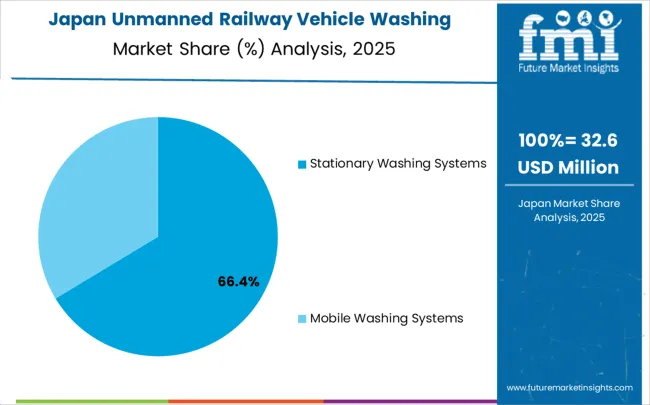
In Japan, the Unmanned Railway Vehicle Washing Systems market prioritizes Stationary Washing Systems, which capture the dominant share of railway depot and maintenance facility installations due to their advanced features, including high-throughput capabilities and seamless integration with existing transportation information technology infrastructure. Japanese rail operators emphasize reliability, cleaning accuracy, and long-term operational excellence, creating demand for stationary systems that provide comprehensive washing capabilities and adaptive maintenance control based on operational requirements and fleet complexity scenarios. Mobile Washing Systems maintains a secondary market position primarily in specialized applications and flexible deployment installations where mobility requirements meet maintenance compliance without fixed infrastructure limitations.
Market Characteristics:
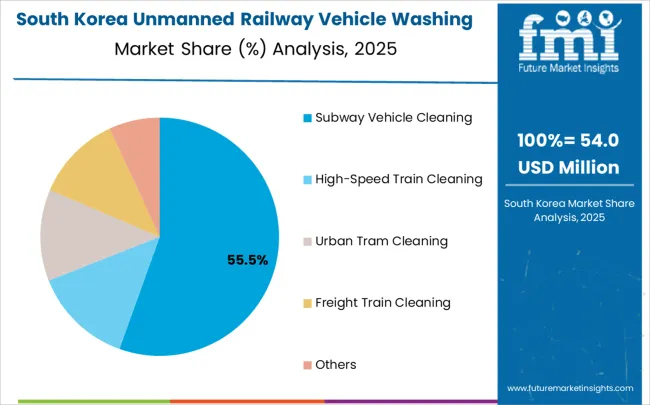
In South Korea, the market structure favors international railway technology companies, including Kärcher, Westmatic, and Aquafrisch, which maintain dominant positions through comprehensive product portfolios and established transportation procurement networks supporting both railway systems and metro facilities. These providers offer integrated solutions combining advanced unmanned washing systems with professional installation services and ongoing technical support that appeal to Korean rail operators seeking reliable automated maintenance systems. Local railway technology contractors and system integrators capture moderate market share by providing localized service capabilities and competitive pricing for standard transportation installations. At the same time, domestic manufacturers focus on specialized applications and cost-effective solutions tailored to Korean railway characteristics.
Channel Insights:
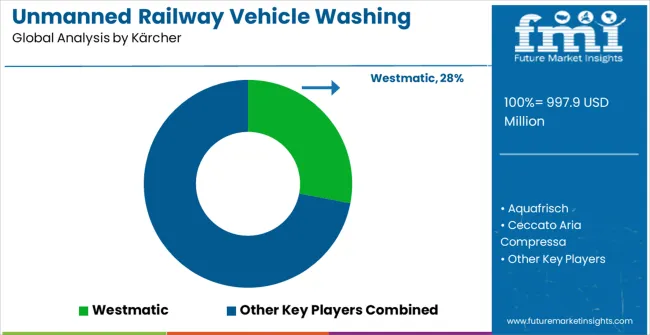
The Unmanned Railway Vehicle Washing Systems market operates with moderate concentration, featuring approximately 15-18 meaningful participants, where leading companies control roughly 58-63% of the global market share through established railway technology relationships and comprehensive cleaning system portfolios. Competition emphasizes advanced washing capabilities, system reliability, and integration with transportation platforms rather than price-based rivalry.
Market Leaders encompass Kärcher, Westmatic, Aquafrisch, Ceccato Aria Compressa, and Cristanini, which maintain competitive advantages through extensive railway technology expertise, global transportation contractor networks, and comprehensive system integration capabilities that create customer switching costs and support premium pricing. These companies leverage decades of cleaning technology experience and ongoing research investments to develop advanced unmanned washing systems with precision cleaning algorithms and maintenance validation features.
Technology Challengers include Istobal, Favagrossa, NERTA, Train-Wash Systems Ltd, and B.I.C. GmbH, which compete through specialized railway cleaning focus and innovative maintenance interfaces that appeal to transportation customers seeking advanced cleaning capabilities and operational flexibility. These companies differentiate through rapid technology development cycles and specialized railway application focus.
Regional Specialists feature companies like Bitimec International, Heilbronn Maschinenbau, Colussi Ermes, Smith Bros & Webb, and Eisenmann GmbH, which focus on specific geographic markets and specialized applications, including high-speed rail systems and integrated maintenance platforms. Market dynamics favor participants that combine reliable cleaning algorithms with advanced railway software, including precision washing control and automatic maintenance monitoring capabilities. Competitive pressure intensifies as traditional transportation equipment contractors expand into automated cleaning systems. At the same time, specialized railway companies challenge established players through innovative washing solutions and cost-effective platforms targeting specialized transportation segments.
| Item | Value |
|---|---|
| Quantitative Units | USD 997.9 million |
| System Type | Stationary Washing Systems, Mobile Washing Systems |
| Application | Subway Vehicle Cleaning, High-Speed Train Cleaning, Urban Tram Cleaning, Freight Train Cleaning, Others |
| Regions Covered | Asia Pacific, North America, Europe, Latin America, Middle East & Africa |
| Countries Covered | China, India, Germany, Brazil, the USA, the UK, Japan, and 25+ additional countries |
| Key Companies Profiled | Kärcher, Westmatic, Aquafrisch, Ceccato Aria Compressa, Cristanini, Istobal, Favagrossa, NERTA, Train-Wash Systems Ltd, B.I.C. GmbH, Bitimec International, Heilbronn Maschinenbau |
| Additional Attributes | Dollar sales by system type and application categories, regional adoption trends across Asia Pacific, North America, and Europe, competitive landscape with railway technology providers and cleaning specialists, rail operator preferences for washing efficiency and system reliability, integration with transportation information systems and maintenance workflows, innovations in cleaning algorithms and automated maintenance, and development of advanced solutions with enhanced throughput and monitoring capabilities. |
The global unmanned railway vehicle washing systems market is estimated to be valued at USD 997.9 million in 2025.
The market size for the unmanned railway vehicle washing systems market is projected to reach USD 1,890.9 million by 2035.
The unmanned railway vehicle washing systems market is expected to grow at a 6.6% CAGR between 2025 and 2035.
The key product types in unmanned railway vehicle washing systems market are stationary washing systems and mobile washing systems.
In terms of application, subway vehicle cleaning segment to command 54.3% share in the unmanned railway vehicle washing systems market in 2025.






Our Research Products

The "Full Research Suite" delivers actionable market intel, deep dives on markets or technologies, so clients act faster, cut risk, and unlock growth.

The Leaderboard benchmarks and ranks top vendors, classifying them as Established Leaders, Leading Challengers, or Disruptors & Challengers.

Locates where complements amplify value and substitutes erode it, forecasting net impact by horizon

We deliver granular, decision-grade intel: market sizing, 5-year forecasts, pricing, adoption, usage, revenue, and operational KPIs—plus competitor tracking, regulation, and value chains—across 60 countries broadly.

Spot the shifts before they hit your P&L. We track inflection points, adoption curves, pricing moves, and ecosystem plays to show where demand is heading, why it is changing, and what to do next across high-growth markets and disruptive tech

Real-time reads of user behavior. We track shifting priorities, perceptions of today’s and next-gen services, and provider experience, then pace how fast tech moves from trial to adoption, blending buyer, consumer, and channel inputs with social signals (#WhySwitch, #UX).

Partner with our analyst team to build a custom report designed around your business priorities. From analysing market trends to assessing competitors or crafting bespoke datasets, we tailor insights to your needs.
Supplier Intelligence
Discovery & Profiling
Capacity & Footprint
Performance & Risk
Compliance & Governance
Commercial Readiness
Who Supplies Whom
Scorecards & Shortlists
Playbooks & Docs
Category Intelligence
Definition & Scope
Demand & Use Cases
Cost Drivers
Market Structure
Supply Chain Map
Trade & Policy
Operating Norms
Deliverables
Buyer Intelligence
Account Basics
Spend & Scope
Procurement Model
Vendor Requirements
Terms & Policies
Entry Strategy
Pain Points & Triggers
Outputs
Pricing Analysis
Benchmarks
Trends
Should-Cost
Indexation
Landed Cost
Commercial Terms
Deliverables
Brand Analysis
Positioning & Value Prop
Share & Presence
Customer Evidence
Go-to-Market
Digital & Reputation
Compliance & Trust
KPIs & Gaps
Outputs
Full Research Suite comprises of:
Market outlook & trends analysis
Interviews & case studies
Strategic recommendations
Vendor profiles & capabilities analysis
5-year forecasts
8 regions and 60+ country-level data splits
Market segment data splits
12 months of continuous data updates
DELIVERED AS:
PDF EXCEL ONLINE
Unmanned Systems Market Analysis - Size, Share, & Forecast Outlook 2025 to 2035
Unmanned Aerial Vehicle Market Size and Share Forecast Outlook 2025 to 2035
Unmanned Marine Vehicles Market Size and Share Forecast Outlook 2025 to 2035
Unmanned Ground Vehicle Market Size and Share Forecast Outlook 2025 to 2035
Unmanned Aerial Vehicles (UAV) Commercial Drone Market Size and Share Forecast Outlook 2025 to 2035
Unmanned Surface Vehicle Market Size and Share Forecast Outlook 2025 to 2035
Aircraft Washing Systems Market Analysis - Size, Share & Forecast 2025 to 2035
Automatic Vehicle Washing System Market
Off Highway Vehicles Brake Systems Market Size and Share Forecast Outlook 2025 to 2035
New Energy Vehicle Electric Drive Systems Market Size and Share Forecast Outlook 2025 to 2035
Vehicle-Mounted Payment Terminal Market Size and Share Forecast Outlook 2025 to 2035
Vehicle Scanner Market Size and Share Forecast Outlook 2025 to 2035
Vehicle-to-grid Market Size and Share Forecast Outlook 2025 to 2035
Railway Communication Equipment Market Size and Share Forecast Outlook 2025 to 2035
Railway Rolling Stock Market Forecast and Outlook 2025 to 2035
Railway System Market Size and Share Forecast Outlook 2025 to 2035
Vehicle Transfer Case Market Size and Share Forecast Outlook 2025 to 2035
Vehicle Barrier System Market Size and Share Forecast Outlook 2025 to 2035
Railway Air Conditioning System Market Size and Share Forecast Outlook 2025 to 2035
Railway Braking System Market Size and Share Forecast Outlook 2025 to 2035

Thank you!
You will receive an email from our Business Development Manager. Please be sure to check your SPAM/JUNK folder too.
Chat With
MaRIA